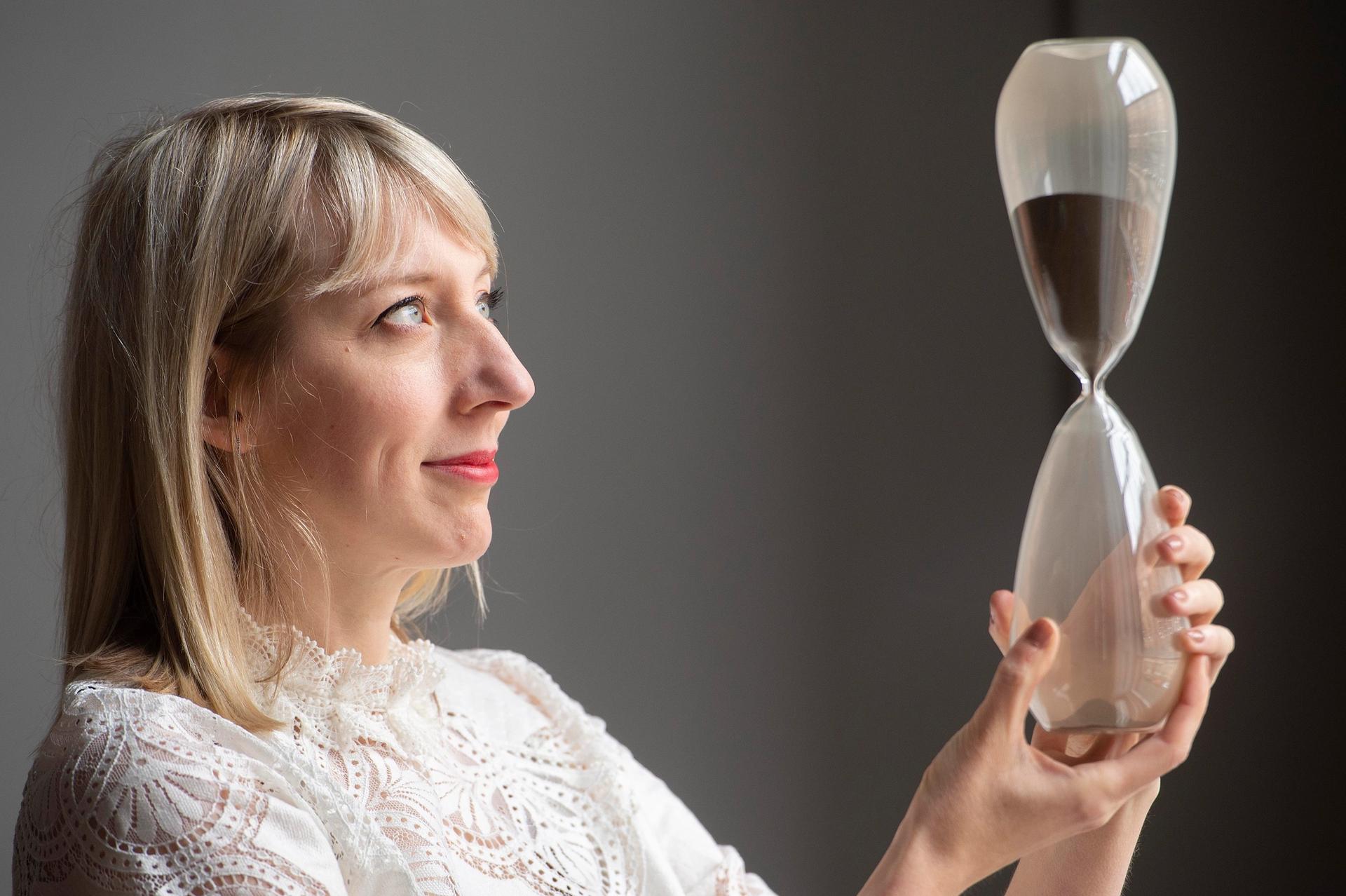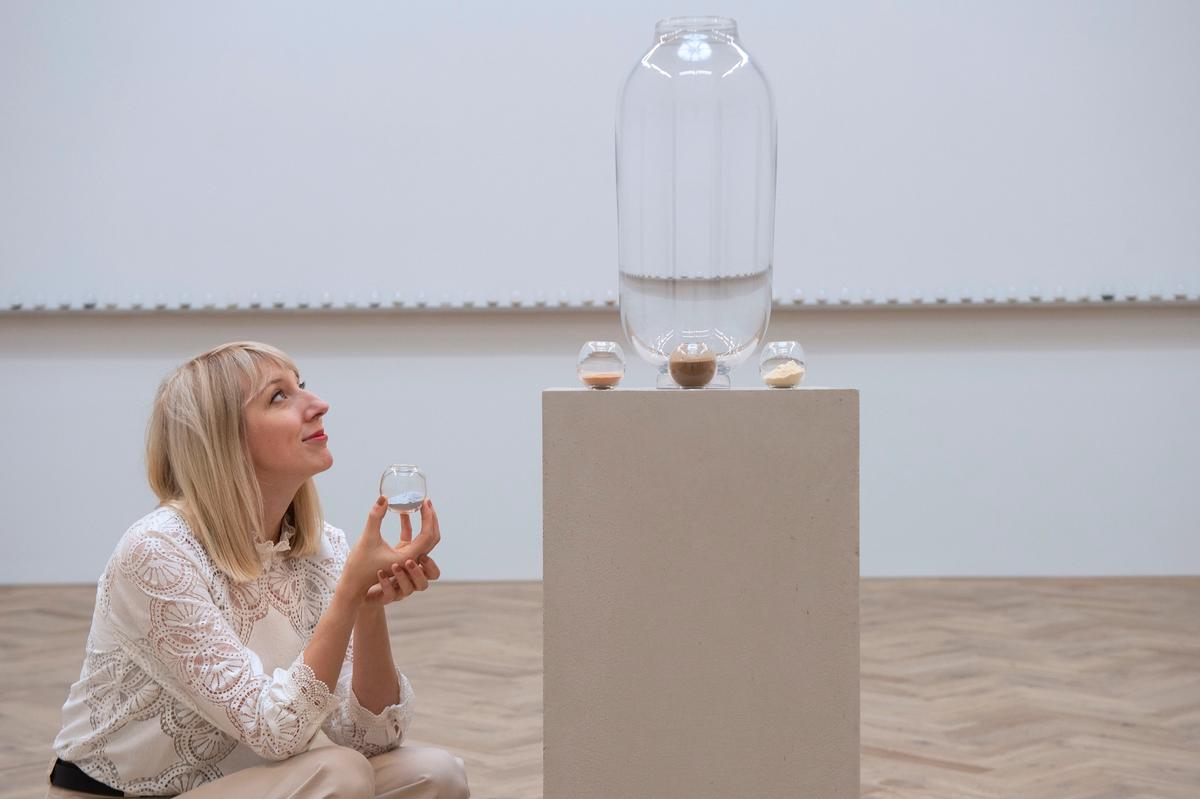The Scottish artist Katie Paterson is showing an urn filled with dust that reflects the story of the Earth at Ingleby Gallery in Edinburgh (Requiem, until 11 June), creating what she has described as “her most political work to date”. The piece is also an “elegy to a disappearing world”, she adds in a statement. The urn will be filled with a vast range of materials ground into dust, from the oldest known rock on Earth dating back to four bn years to microplastic from tyres and a stopwatch used to time bombings in the Iraq War (2003-11).
“What you see in the centre of the room is an empty glass urn that I had hand blown at the National Glass Centre [in Sunderland], which commissioned the work,” the artists explains. “The urn, which sits in the space, was empty to start with. Around all four walls, there are 364 glass vials—small glass cups that each contain a layer of dust. Day by day, visitors lift the little cups and pour the dust in, one by one.” When the urn is full at the close of the exhibition, it will go on show at the National Glass Centre.
The geologist, Jan Zalasiewicz, professor at the University of Leicester, UK, has written a description of every single layer in the urn, which has been printed as a newspaper. He put Paterson in touch with geologists and paleontologists worldwide, enabling her to gather materials. The first layer is material from before even the sun existed, Paterson says “Not only before the earth, but before the sun formed (a mix of materials from asteroids and meteorites).” These presolar grains are tiny mineral fragments that formed as ancient stars exploded.

Artist Katie Paterson with her new art work The Moment, a hand blown glass work with pre-solar material. Photo: Neil Hanna
“Requiem is responding to the state of the earth right now, in that we have ecological systems collapsing and wars going on around us. The urn contains the remnants of civilisations that have come and gone, and conveys the miraculous web of life that's evolved over billions of years, allowing us to be here right now, and alive,” Paterson says.
“There's talk of this century potentially being the last for humanity. Extinction unfolds around us and there's so many threats upon us. The work is quite loaded and I guess, quite emotional. I've certainly found it emotional, gathering these relics of our history.”
She explains the genesis of the piece, explaining how she made a work (Fossil Necklace) that charted all of geological time, throughbeads carved out of fossils which were strung as a necklace. “I had an image of the remains of the fossils turning to dust. And so I worked from there—the necklace spanned geological time but the urn covers all of time as we know it,” she says.
Another work on show at Ingleby, Evergreen,also reflects our ecological-crisis. “We had a botanical illustrator draw every extinct plant. And then we've woven that into a design, which mimics an embroidery May Morris made during the Arts and Crafts movement. We've used the outline of Morris’s vine in the original embroidery Owl, but instead of glorious flowers from that moment in time, we've replaced them with extinct flowers today,” Paterson says.

Still from Future Library, A Century Unfolds (2019), which documents Paterson's ongoing work Future Library
Paterson’s other projects include a new sculpture for Apple’s headquarters in Cupertino, California. “It's called Mirage. It's a collaboration with architects Zeller & Moye. It's going to be a glass sculpture made of sand from every desert on earth,” she says.
An ongoing project is Future Library, which began in 2014 and will take a century to realise. In May 2014, 1,000 Norwegian spruce trees were planted in a forest near Oslo, and in just under a century’s time they will be felled to create the paper for an anthology of texts written by 100 authors. Each text is submitted yearly and will remain unseen until published in 2114.
“We've got three authors handing over their manuscripts together in the forest: Karl Ove Knausgaard, Ocean Vuong and Tsitsi Dangarembga,” Paterson says. “And after the forest ceremony, we're going to the library. I've made a 'Silent Room' with the architects Lund Hagem and Atelier Oslo. The room is located on the top floor of the new library, made out of the wood from the forest. One hundred cast glass drawers are going to hold the authors manuscripts for the coming century."


